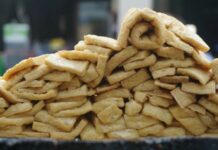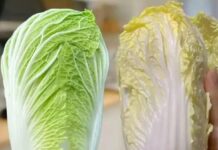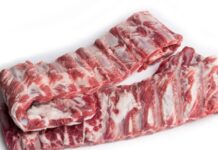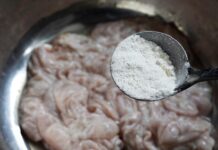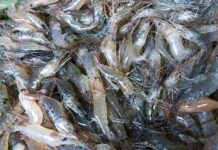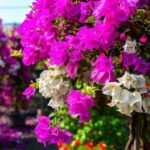During the Tet holiday in Vietnam, families have a tradition of buying various potted plants to decorate their homes and bring good fortune for the upcoming year. One of the most popular choices is the money tree, a beloved plant with a special significance. Let’s delve into the meaning and beauty of this plant in the article below!
1 What is a Money Tree?

The money tree, scientifically known as Zamioculcas zamiifolia, is a flowering plant native to Africa. It grows in clusters, featuring a swollen base that acts as a water reservoir. Its leaves boast a lush green hue, while its branches grow upright with a slight curve, giving the plant a balanced and harmonious appearance.
Due to these characteristics, the money tree is adaptable to indoor environments and doesn’t require intense light or frequent watering. It can even thrive in dry conditions.
2 Benefits and Effects of the Money Tree
Benefits of the Money Tree

The money tree, with its elegant and lush presence, adds a touch of greenery and natural beauty to your home, infusing it with a vibrant and fresh atmosphere.
Additionally, the money tree possesses air-purifying properties, creating a healthy living environment for you and your loved ones. According to a 2014 study conducted by the University of Copenhagen, this plant can eliminate up to 0.01 mol/m2 of volatile organic compounds, such as benzene, toluene, ethylbenzene, and xylenes, on a daily basis. This significantly improves the air quality within your home.
Effects of the Money Tree
According to the journal Water, Air & Soil Pollution, the money tree is three times more effective at purifying the air than the snake plant. It also aids in removing harmful gases from the environment, including carbon dioxide, benzene, toluene, and xylene.
By incorporating money trees into your home, you not only elevate its aesthetic appeal but also reap the benefits of their air-purifying qualities, as they release oxygen into your living space.
Furthermore, due to its positive symbolism in feng shui, the money tree is often presented as a housewarming or business opening gift.
3 Significance of the Money Tree During Tet

In addition to its air-purifying benefits, the money tree holds a special significance during Tet. From a feng shui perspective, the upward-growing leaves and branches of the money tree resemble a hand receiving fortune. As a result, many people believe that it attracts wealth, prosperity, and good luck to its owner.
4 Feng Shui Compatibility of the Money Tree

The money tree is believed to bring good fortune and is particularly favored by business owners and office workers. Its very name holds a positive meaning in feng shui, symbolizing prosperity and smooth sailing in business ventures.
Feng shui practitioners consider the money tree beneficial for various aspects of life, including health, wealth, and academic pursuits. Anyone can grow this plant as a decorative piece or a symbol of good luck. To maximize its feng shui benefits, consider the following tips:
– For individuals with Wood or Fire elements: The money tree is an excellent choice, as Wood fuels Fire in the productive cycle of the five elements.
– For individuals with an Earth element: Earth is considered nourishing for plant growth. When purchasing or planting a money tree, opt for a red, pink, or purple pot or vase, which represent Fire colors, to create a mutually beneficial relationship.
– For individuals with Metal or Water elements: These elements are contrary to Earth. It is recommended to select a white or yellow pot, as these colors are very supportive. Metal produces Water, and Water nourishes Wood.
5 Ideal Placement of the Money Tree
In addition to considering the plant’s shape and the color of its pot, it is crucial to choose a suitable location for your money tree. This ensures harmony in feng shui and provides the plant with the necessary light and growth conditions.
Placement in Entrance Halls or Lobbies
For office buildings or houses with spacious and well-lit entrance halls, placing a large money tree on a high pedestal in the east, which corresponds to the?qu? (Ch?n) and the Wood element, or in the southeast, which corresponds to the ?qu? (T?n) and the Wood element, is considered auspicious in feng shui.

Placement on Work Desks
For office workers and those in finance-related professions, placing a small money tree on their desks is believed to promote smooth work processes, profitability, and career advancement. The compact size of the money tree also makes it an ideal desk accessory, uplifting the spirits of office workers.

Placement Near Windows or Balconies
If your home features spacious windows or balconies, consider placing a money tree nearby to help regulate indoor air quality and add a modern touch to your interior design.
Note: Although the money tree is generally considered auspicious in feng shui, avoid placing it in the bedroom, as its strong yang energy can disrupt the balance of yin and yang, impacting sleep quality.
6 How to Choose a Money Tree for Good Luck
Knowing how to select a money tree can bring good fortune to its owner. When purchasing, inspect the root ball to ensure it is intact and not overly compacted or waterlogged.
The tree’s size is less important than the uniform height of its branches and leaves, which should be undamaged and intact. Additionally, choose a tree with inner leaves that are taller than the outer ones.

When selecting a pot, opt for one that is slightly larger than the current root ball to accommodate future growth. Ensure that the pot has drainage holes to facilitate water drainage and promote healthy root development.
7 Caring for and Growing a Money Tree Effectively
Planting a Money Tree
Avoid planting the money tree in clay soil, as its dense structure can cause waterlogging, leading to root rot and leaf yellowing. It is recommended to replace the soil every three months.
Instead, plant the tree in well-drained, airy soil with a high organic matter content. Enhance drainage by mixing it with rice husk ash or crushed honeycomb charcoal.
Alternatively, you can use commercially available bio-soils specifically designed for potted plants, saving you time and effort in maintenance.

Caring for a Money Tree
Watering: The money tree thrives with minimal watering. Overwatering can lead to root rot and leaf drop. Spray the plant with water once a week, avoiding excessive moisture. Every four to five weeks, take the plant outdoors (in a sunny spot) and give it a thorough watering. Allow it to dry before bringing it back inside or placing it on your desk. If grown outdoors or in a bright area, reduce the watering frequency.

Nutrition: Before planting, mix the airy soil with slow-release fertilizer for potted plants, wood ash, or crushed honeycomb charcoal to provide the necessary nutrients for the tree’s long-term growth.
When the tree is about to produce new branches, apply NPK fertilizer to boost its growth. Be sure to apply the fertilizer 10 cm away from the trunk to avoid damaging the roots.
Light: The money tree can tolerate both low-light and bright conditions. However, ensure it receives adequate light by periodically placing it in a sunny location. Avoid prolonged direct sunlight, as it can scorch the leaves. If the leaves turn yellow due to insufficient light, move the plant to a brighter spot, such as a balcony or windowsill.
Temperature and Humidity: The optimal temperature range for the money tree’s growth is 25-27°C. The tree may enter a dormant state and stop growing if the temperature drops below 18°C, and it will not survive extreme cold temperatures below 5°C. The tree struggles to grow normally in both low and high humidity conditions.
Preventing Pests and Leaf Yellowing

The money tree is naturally resistant to pests and diseases. However, if the growing conditions are imbalanced, it may still be affected by common issues such as leaf yellowing and loss of leaf color, typically caused by insufficient light and overwatering.
If your money tree’s leaves turn yellow: Adjust the amount of water you give the tree daily based on its size and soil type. First, remove any wilted or yellow leaves, and regularly place the plant in a cool, shaded area, avoiding direct sunlight.
If your money tree is infested with insects: The undersides of the leaves are often targeted by aphids and other small insects. To get rid of them, spray the leaves with a diluted soap solution, then remove the infested leaves and place the plant in direct sunlight to strengthen the remaining leaves.
8 Is the Money Tree Poisonous?

According to a study by the University of Bergen in Norway, the leaves and stems of the money tree contain high levels of calcium oxalate, a substance that can cause irritation if it comes into contact with sensitive skin or mucous membranes in the mouth, eyes, or tongue. In severe cases, it can lead to breathing difficulties, digestive issues, seizures, or even coma.
Therefore, when keeping a money tree indoors, exercise caution and closely supervise young children to prevent them from touching the plant’s sap or accidentally ingesting its leaves, as this can have serious health consequences if left untreated.
9 How Much Does a Money Tree Cost?
Small Money Trees for Desks
Small money trees, typically 20-30 cm in height, are perfect for placement next to computers, on desks, near TVs, or in drinking areas. They usually cost between 150,000 and 200,000 VND.
Medium-Sized Money Trees
Medium-sized money trees, with a height of 50-60 cm, are often placed in corners, hallways, or near cash registers and reception desks. They typically range in price from 250,000 to 300,000 VND.

Medium-Large Money Trees
Money trees in the medium-large category, with a height of 80-100 cm, are often grown in slightly larger pots with decorative gravel. They are commonly placed in reception areas, near











